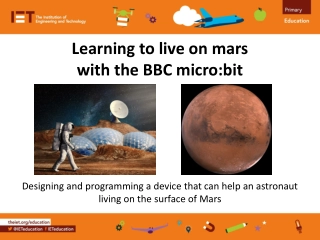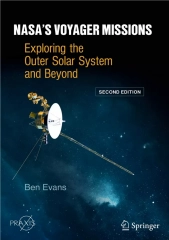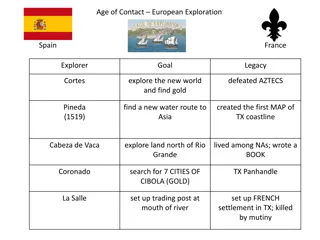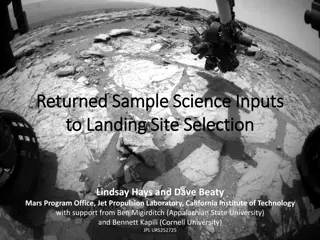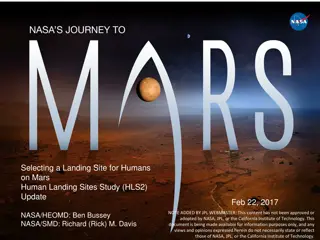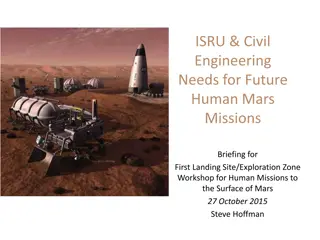Current Mars Missions and Future Plans
Mars currently has 8 active missions operated by various space agencies, with 3 more planned for the future. Organizations involved include NASA, ESA, ISRO, and individuals like Elon Musk. Missions like Curiosity, ExoMars Trace Gas Orbiter, and Mars 2020 Rover aim to explore Martian climate, geology, search for signs of life, and prepare for human missions. The mission objectives range from investigating habitability to searching for biosignatures and caching samples. Plans also include sending humans to Mars in theoretical proposals.
Uploaded on Sep 19, 2024 | 1 Views
Download Presentation

Please find below an Image/Link to download the presentation.
The content on the website is provided AS IS for your information and personal use only. It may not be sold, licensed, or shared on other websites without obtaining consent from the author.If you encounter any issues during the download, it is possible that the publisher has removed the file from their server.
You are allowed to download the files provided on this website for personal or commercial use, subject to the condition that they are used lawfully. All files are the property of their respective owners.
The content on the website is provided AS IS for your information and personal use only. It may not be sold, licensed, or shared on other websites without obtaining consent from the author.
E N D
Presentation Transcript
WHY MARS? CURRENT PLANS Group 4 - Acacia Davis, Gregory Kim, Emily Mares, Jimmy Song
There are currently 8 missions operating on Mars with 3 officially planned for the future. Groups involved include: NASA The European Space Agency (ESA) The Indian Space Research Organisation (ISRO) These organizations and independents such as Elon Musk have also proposed theoretical plans of sending humans to Mars. http://www.planetary.org/explore/space-topics/space-missions/missions-to-mars.html
Active Missions Curiosity (2011 Launch, NASA) Mars Odyssey (2001 Launch, NASA) ExoMars Trace Gas Orbiter (2016 Launch, ESA) Maven (2013 Launch, NASA) Mars Orbiter Mission (2013 Launch, ISRO) Mars Reconnaissance Orbiter (2005 Launch, NASA) Mars Exploration Rover Opportunity (2003 Launch, NASA) Mars Express and Beagle 2 (2003 Launch, NASA)
Active Mission - Curiosity Rover Rover is size of a car. Goals: Investigation of the Martian Climate and Geology to see if Gale Crater has ever offered environmental conditions favorable for microbial life. Curiosity s design serves as the basis for the planned mars 2020 mission.
Active Mission - ExoMars Trace Gas Orbiter First in a series of Mars missions taken by two space agencies, ESA and Roscosmos. (Rover to be sent in 2021). Objective is to search for evidence of methane and other trace atmospheric gases that would evidence active biological/geological processes using four instruments in its payload. Also used to test key technologies for future missions from the ESA.
Active Mission - ExoMars Trace Gas Orbiter The Trace Gas Orbiter carries the entry, descent and Landing Module (Schiaparelli), which was supposed to be used to monitor surface- conditions. However, Schiaparelli failed after crashing during its landing. Orbiter right now is in aerobraking to adjust its speed to orbit above the planet, with science activities scheduled to begin in late 2017.
Mars 2020 Rover Mission NASA plans to launch a new rover mission in July/August 2020 with four main science objectives: Looking for habitability Seeking biosignatures Caching samples Preparing for humans
Mars 2020 Rover Mission Mars as a Place for Life All four of these objectives relate to exploring the potential of Mars as a place for life. Finding environments that could have supported life, as well as direct evidence of life, can help improve our understanding of Mars. This helps pave the way for eventually having human life on Mars.
Mars 2020 Rover Mission - Technological Innovation The 2020 mission would continue the work of past rover missions by continuing to innovate: More precise and adaptive entry, descent, and landing procedures A drill for coring samples of Martian rock The capability to store the samples in caches which could be returned in future missions.
Mars 2020 Rover Mission - Preparing for Human Life This rover will carry technology for extracting oxygen from the Martian atmosphere, identifying resources such as subsurface water, and characterizing weather conditions. New technology will help scientists test ways of supporting human life and future missions with Mars' natural resources.
NASA: Journey to Mars Nasa has made the goal of sending humans to Mars in the 2030s with 3 main stages: Earth Reliant The Proving Ground Earth Independent https://www.nasa.gov/content/journey-to-mars-overview
NASA: Journey to Mars - Earth Reliant Now - Mid 2020s Focuses on research aboard the ISS: Testing psychological and physical effects Testing new technologies and communication systems https://www.nasa.gov/content/journey-to-mars-overview
NASA: Journey to Mars - Proving Ground 2018 - 2030 Missions near the moon: Testing the skills needed for Mars Sending humans farther into space than travelled before Capturing and exploring an asteroid https://www.nasa.gov/content/journey-to-mars-overview
NASA: Journey to Mars - Earth Independent Now - 2030s & Beyond Getting humans into low orbit around Mars: Testing entry and landing onto the surface Studying necessary resources to live on the surface Mars 2020 is part of this stage https://www.nasa.gov/content/journey-to-mars-overview
SpaceX - Objectives Mars as an alternative to planetary extinction Red Dragon, 2018-2022 Mars flights by 2023 Reusable booster, tanker, ship http://www.spacex.com/sites/spacex/files/mars_presentation.pdf
SpaceX: Red Dragon - The Trip http://www.spacex.com/sites/spacex/files/mars_presentation.pdf
SpaceX: Red Dragon - The Trip http://www.spacex.com/sites/spacex/files/mars_presentation.pdf
SpaceX: Red Dragon - The Destination Evaluate hazards and surface qualities Refine payload transport & landing Scout resources for propellant plant (CH4/O2) http://www.spacex.com/sites/spacex/files/mars_presentation.pdf
SpaceX - Benefits and Challenges Coordination with government Funding source is unclear <$140,000/ton Make space more accessible to the public http://www.spacex.com/sites/spacex/files/mars_presentation.pdf
Further missions to Mars and even human exploration is being taken seriously by many groups; the experts are ready to go, so why isn t society?


